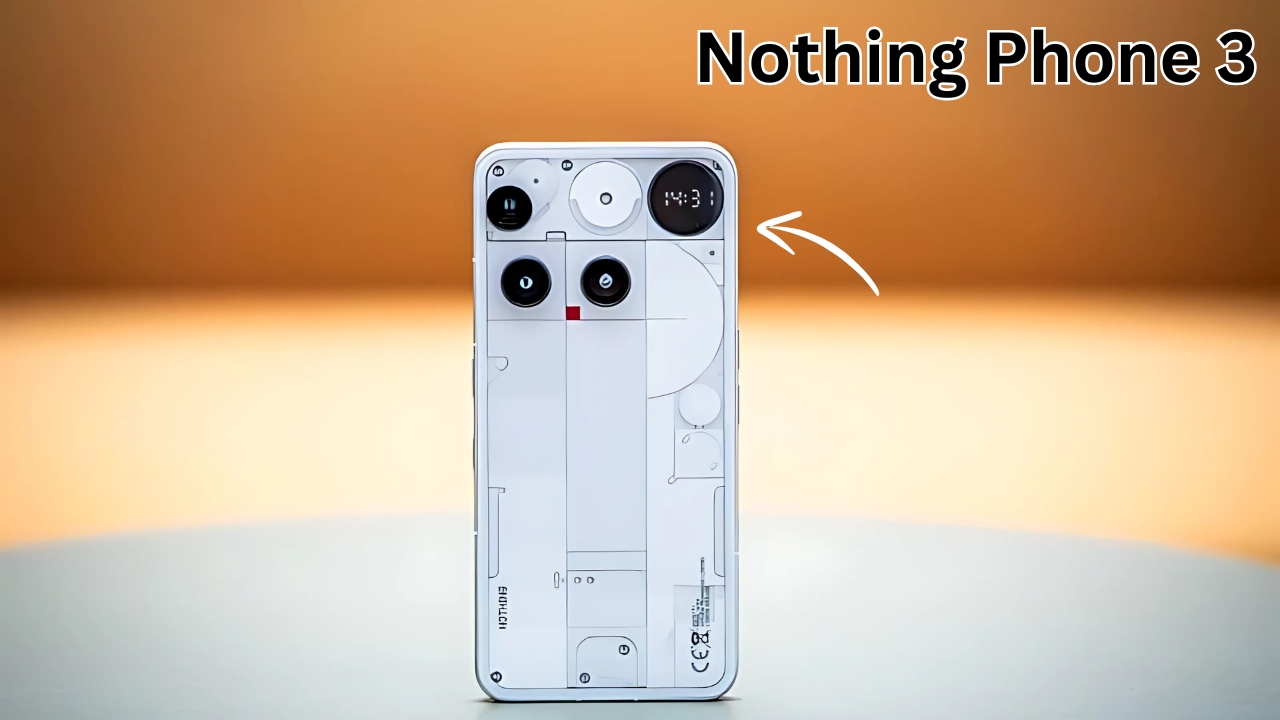Nothing Phone 3 : Sometimes the best ideas seem crazy until they work. Nothing just proved this with their Phone 3 launch, swapping out the beloved LED light strips that made them famous for something nobody saw coming—a tiny interactive screen on the back of the phone that actually makes sense.
When Less Becomes More: The Glyph Matrix Revolution
Here’s the thing about the original Glyph Interface: it looked amazing but felt limited. Those segmented lights could flash and pulse in patterns, creating beautiful light shows that told you someone was calling or your battery was charging. Cool? Absolutely. Practical beyond the initial wow factor? That’s where things got murky.
The new Glyph Matrix flips this script entirely. Nothing officially launched its Phone 3 on July 2, replacing the signature LED light strips with a compact 489-micro-LED “Glyph Matrix” display that shows notifications, animations, and mini-games on the device’s back. Instead of abstract light patterns, you get actual information displayed in pixelated clarity.
The display itself measures just 25-by-25 pixels, but those limitations force creativity rather than hinder it. Think early video game aesthetics meeting modern smartphone functionality. It’s deliberately constrained, which paradoxically makes it more useful than an overcomplicated secondary screen might be.
What really sells the concept is how Nothing handles interaction. There’s a physical button built into the rear glass—not visible, but definitely tactile—that lets you cycle through different functions without ever touching the main screen. This feels surprisingly natural once you get used to it.

Gaming Gets Weird in the Best Possible Way
Nobody asked for smartphone games played on a tiny dot matrix display, but now that they exist, they’re oddly compelling. The Glyph Toys collection includes classics like Rock Paper Scissors and Magic 8 Ball, plus original creations like Spin the Bottle that seem designed specifically for awkward social situations.
These aren’t trying to compete with conventional mobile games. They’re something entirely different—digital fidget toys that happen to live on your phone’s back. The constraint of working within such a small, low-resolution display forces developers to think creatively about game mechanics and user interaction.
An open SDK means this is just the beginning. Third-party developers can now create their own Glyph experiences, potentially spawning an entirely new category of micro-games and utilities designed for always-accessible, glanceable interaction.
Hardware That Backs Up the Hype
Underneath all the visual innovation sits genuinely competitive hardware. At $799, the Phone 3 undercuts a lot of high-end rivals while packing features that feel anything but budget. The Snapdragon 8s Gen 4 processor might not be the absolute top-tier chip, but it delivers flagship-level performance while keeping power consumption reasonable.
Memory configurations feel generous: the base model includes 12GB RAM with 256GB storage, while the premium variant bumps up to 16GB RAM and 512GB storage for $899. These aren’t the kind of compromises you typically see at this price point.
The camera system takes an interesting approach by making every sensor 50MP. Main camera, ultra-wide, periscope telephoto, and even the selfie camera all share the same resolution. This creates consistency across different shooting scenarios while simplifying the user experience—no need to worry about which camera delivers the best quality.
Battery Life That Actually Lasts
Here’s where Nothing made a genuinely smart engineering decision. The 5,150mAh silicon-carbon battery represents a significant upgrade over traditional lithium-ion technology, offering higher energy density in roughly the same physical space.
Real-world testing suggests the Phone 3 can easily handle two days of typical usage, which puts it ahead of most flagship competitors. The 65W fast charging capability means even heavy users can quickly top up during brief breaks rather than planning their day around charging schedules.
Wireless charging at 15W might not be the fastest available, but it’s adequate for overnight charging or quick top-ups. The inclusion of 5W reverse wireless charging adds practical utility for sharing power with accessories or helping friends in battery emergencies.
Software That Makes Sense
Nothing OS 3.5 feels like a mature Android experience rather than a heavy-handed customization. The AI features focus on practical utility—Essential Search provides natural language queries across device content, while “Flip to Record” offers meeting transcription when you place the phone face-down.
These implementations feel thoughtful rather than gimmicky. They solve real problems without creating new complexity, which aligns perfectly with Nothing’s design philosophy of making technology more human and accessible.
The promise of five years of Android updates and seven years of security patches demonstrates serious commitment to long-term device support, matching or exceeding what established manufacturers offer.
Market Reality Check
The Phone 3 enters a brutally competitive market where Samsung and Apple dominate mindshare and shelf space. But Nothing isn’t trying to beat them at their own game—they’re creating an entirely different category of premium smartphone that prioritizes personality over pure performance metrics.
Early reactions suggest this strategy might work. The Phone 3 offers experiences that simply aren’t available elsewhere, regardless of budget. That kind of genuine differentiation is rare in today’s smartphone landscape, where most “innovations” amount to incremental improvements to existing features.
Nothing Phone 3 The Future Looks Interesting
Whether the Glyph Matrix becomes a defining smartphone feature or remains a quirky Nothing exclusivity depends largely on user adoption and developer creativity. But the early signs are promising—this feels like the kind of feature that starts conversations and changes expectations about what smartphones can be.
Nothing has always been about challenging conventions in mobile technology. With the Phone 3, they’ve managed to be different without sacrificing functionality, which might be the most impressive achievement of all.
